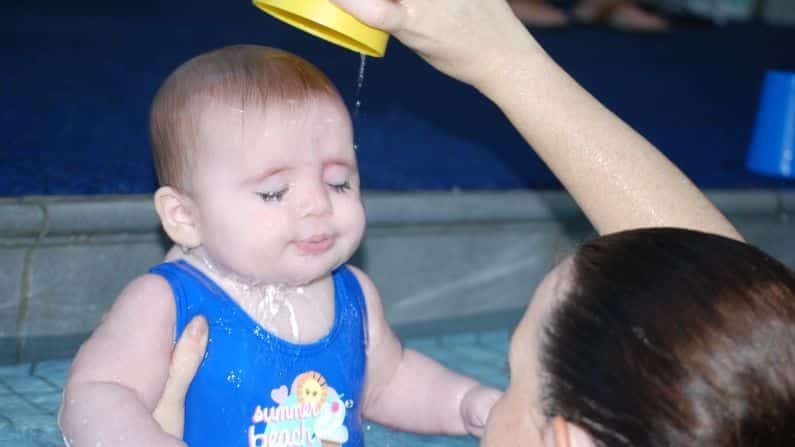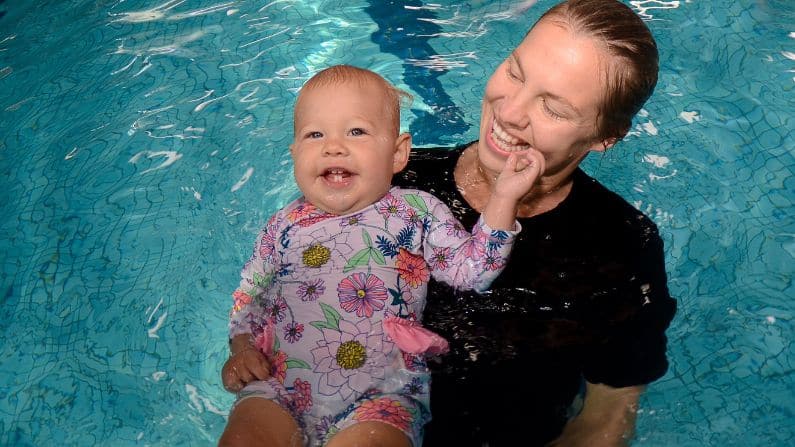Teaching an infant swimming skills and many other age groups requires certain basic principles. These include; water familiarisation, breath control, submersion, free-floating, prolusion and breathing. It is important that these learn to swim principles are followed meticulously to maximise results. Trying to force or hurry the learn-to-swim process will result in poor swimming skills.
When can an infant start swimming?
The learn-to-swim process should start at birth. Newborn babies are like little sponges, soaking up information from their new environment. After being contain protected and immersed in a watery environment for nine months, infant swimming progresses.
Learning takes place via their senses, so, stimulation of sight, sound, taste, touch, and smell, all become vitally important in baby’s physical, emotional, and psychological development.
Water is a perfect medium to stimulate the baby. The bath becomes a place of fun, enjoyment, stimulation and learning. Parents should provide cuddling, playing and communicating opportunities as part of the daily bath routine. These early learning experiences in the bath are actually the child’s first informal swimming lessons.
Newborn babies have been immersed in the womb for nine months and therefore know no fear of the water. They appreciate, love and enjoy the stimulus that comes for being in warm water, and hence are more accepting of the conditioning process which we use to prepare them for their first underwater experience outside the womb.
Conditioning is a stimulus-response method used to teach babies to hold their breath in response to verbal triggers. By using this method of conditioning, the parent will teach the baby breath control on command.
Conditioning is important because it prepares the child for his or her first underwater experience outside the womb. If incorporated and practised regularly in the daily bath routine, by 4 months the child will be ready for a trauma-free submersion.

What are babies capable of achieving in the pool?
Children do not have the fine motor skills to perform the correct freestyle action until the age of 4. However, infants can be independently mobile in the water long before this age. Instead of using freestyle, babies use primitive movements to propel themselves through the water. When babies are very young these movements resemble a dolphin-like wriggle. As children begin to crawl they use a similar action to propel themselves through the water.
Laurie Lawrence, Australia’s water safety advocate and baby teaching expert has been researching and documenting infant learn to swim for the past 31 years. His studies give great insight into what babies are physically capable of achieving in the lesson. As long as children have been conditioning and are exposed to the water regularly – at least twice per week, parents can expect the following.
4-8 Months
During the 4-8 month age group children can; submerge, free float, back float, grip and kick.
8-12 Months
Between 8-12 months children can; free float long distances, float and pull up independently on a shallow ledge, start turning.
12-18 Months
During the 12-18 month age group children can; swim short distances unaided, turn unaided to an adult, turn unaided to the ledge.
18-24 Months
During 18-24 months children can; swim longer distances, turn unaided and climb out of the pool, independently swim around adults, turn to a high wall, pick up rings off the bottom of the pool.
2-3 Years
During the 2-3 year age group children can; kick using a kickboard, back float independently, swim and breathe independently.
3-4 Years
During the 3-4 age group, children begin to gain better control over their body movements and will refine their swimming skills.

Water Safety
Drowning is the greatest cause of accidental death in children under the age of 5 in Australia. On average, 1 child drowns each week. Similar statistics can be seen worldwide. Water safety is the responsibility of all adults caring for children. Children must never be left unsupervised in or around water. Laurie Lawrence’s, drowning prevention campaign, “Kids Alive”, stresses the importance of;
1. Fence the pool,
2. Shut the gate,
3. Learn to swim,
4. Supervise,
5. Learn resuscitation.
For more information on Laurie’s Kids Alive Program, visit www.kidsalive.com.au
Learn more about infant aquatics with our Swim Library
